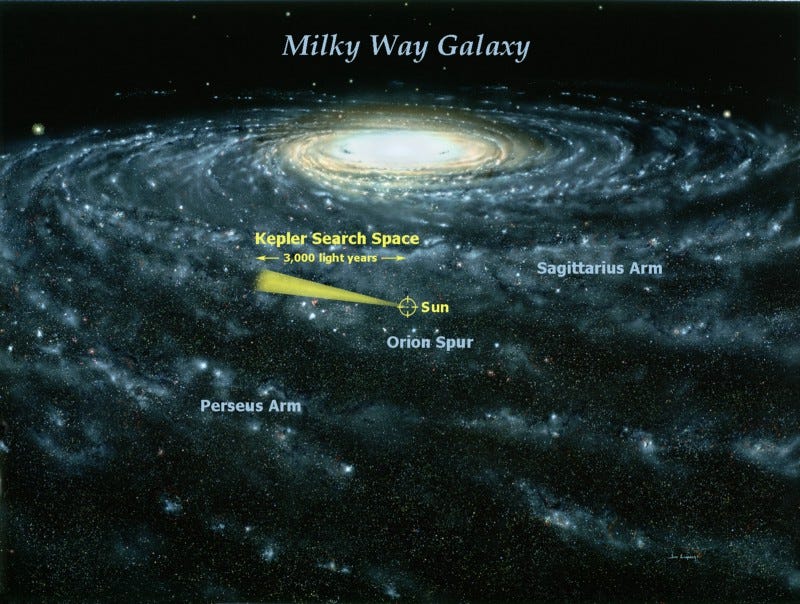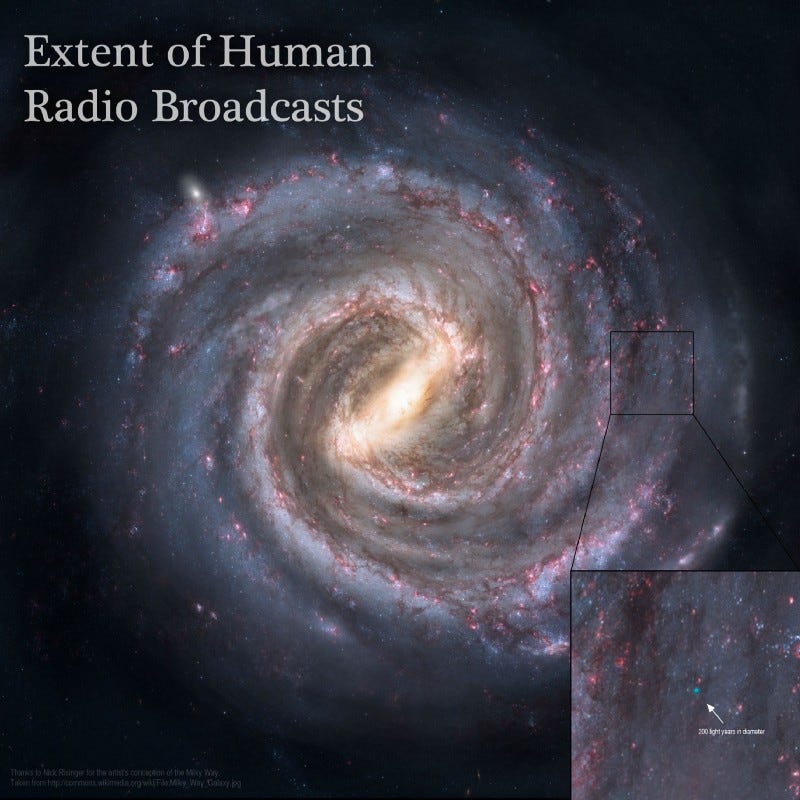Is the Fermi Paradox really a paradox?
The answer could be hiding in the Drake equation itself.

What is the Fermi Paradox?
The Fermi Paradox is the stark contradiction between the high probability estimates of Extraterrestrial Life existing and the lack of evidence for the same. The basic arguments goes like this:
- There are about 100 billion sun-like stars in our galaxy, some even older than our Sun.
- Most of these stars ought to have planets around them. That makes for hundreds of billions of planets. Many of them will be potentially habitable.
- Some of those planets can give rise to Life. And some of those can give rise to intelligent life too. That amounts to potentially millions of worlds with intelligent civilizations.
- Some of these civilizations might develop Interstellar travel. Even at a slow place, the galaxy can be colonized in less than a million years!
So the question is: If there are so many potential extraterrestrial civilizations, then why haven’t we come in contact with any such civilization at all? That’s the supposed paradox. The full argument of the Fermi Paradox can be found at Wait But Why.
There are essentially 2 points where the Fermi Paradox can fall apart, the very seeming contradictions:
- The estimate of the number of extraterrestrial civilizations that can communicate with us.
- The lack of any evidence of contact with an extraterrestrial civilization.
Point 2 has no meaning if the estimate of point 1 is incorrect. Point 1 (i.e number of civilizations with whom communication is possible) is given by the Drake equation that can be summarized as follows:

Let us look at each of the parameters in the Drake equation. Astrophysics has advanced enough to let us reliably estimate the first 2 parameters:
- The average rate of star formation in the galaxy: (R*)=1.5–3 stars/year.
- The fraction of those stars with planets: f(p)=~1.
So the first 2 parameters present no problem. The subsequent parameters however are very crudely estimated which means there are large uncertainties attached with them.
Problem #1: Our estimates of Habitable Planets is biased: n(e)
The Kepler space telescope (which represents not all but most of our progress on finding habitable planets) looked only in a small nearby corner of our galaxy, shown by the highlighted yellow part in the following image:

- It means that our search for habitable worlds has just begun. Hence, our estimate of the total habitable worlds in the galaxy is extrapolated from just a small observed corner.
- Our estimates of the number of habitable worlds is also biased on the conditions for Life in this observed corner. The conditions for Life are not the same throughout the galaxy, some parts of the Milky Way are more habitable than others. For example, the central parts of the galaxy are more radiation prone than the outer parts where we reside.
- Moons of planets don’t need to be in the habitable zone of the star to be able to produce Life. The gravitational pull of gas giants like Jupiter combined with a moon’s elliptical orbit creates internal friction on such moons. This leads to internal heating and availability of energy resources that can be exploited by a potential life form. The problem is that we don’t know how to estimate such habitable moons. We don’t even know many exomoons, much less learning about their habitability.
- We have no idea if the planets in close orbits around the cooler red dwarf stars are truly habitable. One such example of a potentially habitable planet is the recently discovered Proxima b. The answer to whether such planets are truly habitable can either be less positive or very positive since red dwarf stars are the most common stars in the galaxy. But the point is that we don’t know yet.
Basically we really have no idea what fraction of the planets (or moons!) in the galaxy are habitable.
Problem #2: Without n(e), we can’t reliably estimate how many planets give rise to intelligent life
Fraction of planets that develop Life f(L): Since we know of only one planet with Life on it, this is an estimate that we can’t realistically make for a long time. Our search for habitable planets needs to substantially widen first for us to be able to get a hold on n(e). And then if we actually discover certain alien life forms, we can say something meaningful about how many habitable planets can actually give rise to Life.
Fraction of planets with Life that develop intelligent life f(i): Without finding many planets/moons with Life first, this estimate is meaningless.
Problem #3: Interstellar communication may not be as popular as we assume it to be.
Fraction of planets with intelligent life capable of Interstellar communication f(c): If we eventually find many planets with Life (and some with intelligent life) over long periods of time, we will be closer than ever to knowing how many can actually develop Interstellar communication. Only then can we have a true estimate of whether or not Interstellar communication is as ubiquitous as we assume it to be. Not to mention that if we do manage to communicate with an intelligent civilization in some way till then, the entire 2nd contradiction of the Fermi Paradox (the lack of evidence of any communication) falls apart anyway.
Problem #4: The time scale of the Universe is too damn big
The average length of time of existence of such civilizations (L): Consider that we humans came on Earth in our current form as an intelligent species about only 200,000 years ago. By comparison, the Earth is 4.5 billion years old and the Universe is 13.7 billion years old! Our existence as an intelligent species has thus been a mere blink of an eye on cosmic scales.
Consider further that we have developed Interstellar communication (via radio) not more than a century ago. So all our efforts to listen to extraterrestrial communication has been for but a puny 100 years.
Similarly, all our radio signals sent in space to advertise ourselves as a technologically advanced civilization has not even reached 100 light years away from us, due to the speed of light limit at which radio waves travel.

Space & time are vast and thus we need to be broadcasting/listening for a really long time to really be able to know if there are any other intelligent civilizations out there. By the time we became technologically capable of Interstellar communication, many such civilizations might have come to life and gone extinct. And after (if) we go extinct, many more civilizations can come and go later.
The galaxy could be a collection of isolated incidences of technologically-able intelligent life forms, who are either too far from each other in space or in time!
Problem #4 is thus the biggest of all. Even if all is assumed positive until the last parameter, the parameter of time can outweigh all of them.
The Fermi Paradox is not really a Paradox
Problems #1–4 prove that unless we know the real values for the Drake equation, arguing further based on assumptions and analogies doesn’t make much sense. A lot of scientific understanding and knowledge is required before we can truly grasp the real extent of the Drake equation.
The good news is that after the successful realistic estimation of the first 2 parameters [the rate of star formation (R*) and the fraction of stars with planets f(p)], we are now on our way to determine the 3rd parameter: The number of habitable planets n(e). Kepler gave a decent start but the TESS space telescope (planned launch in March 2018) will take it much further, being specifically designed to look not just for extrasolar planets, but those in the habitable zone of their stars.

The task will further be helped by the awaited James Webb Space Telescope (to be launched in 2019) and the upcoming big Earth-based telescopes.
So yeah, the Fermi Paradox is not really a paradox. Not yet anyway. It is more apt to call it the Fermi Problem. And we are on our way to figure out the real value of the Fermi Problem.
Slowly but steadily, Science marches on its way to knowing the ultimate truth, or if there is one.
